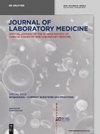Reference intervals of homocysteine in apparently healthy Chinese Han ethnic adults
IF 1.8
4区 医学
Q4 MEDICAL LABORATORY TECHNOLOGY
引用次数: 1
Abstract
Abstract Objectives The aim of this study was to establish reference intervals (RIs) of homocysteine (Hcy) in healthy Chinese Han ethnic adults according to the Clinical and Laboratory Standard Institute (CLSI) CA28-A3. Methods After filtering, serum Hcy values in 20,810 healthy subjects from a middle area of China (Wuhu, Anhui province) were measured. The non-parametrical percentile method was used to establish RIs and the 90% confidence intervals of lower and upper limits were calculated. The relationship between Hcy and age was analyzed by using Spearman’s approach. Besides, the risk of HHcy in males and females was examined by logistic regression analysis. Results The RIs of Hcy were 9.10–20.20 μmol/L for males, 6.10–15.90 μmol/L for females and 8.00–19.80 μmol/L for total subjects from 20 to 90 years old. The serum Hcy level was significantly correlated with age both in males (r=0.2159, p<0.0001) and females (r=0.2955, p<0.0001). In males, the prevalence and the risk of HHcy were higher than females of all ages (p<0.001). Conclusions Through the analysis of a large dataset from healthy population, it showed that the variations in different age- and sex-related RIs of Hcy were significant. It suggested that establishing more specific age- and sex-related RIs for Hcy in China is necessary.表面健康的中国汉族成人同型半胱氨酸的参考区间
摘要目的本研究的目的是根据临床与实验室标准研究所(CLSI)CA28-A3建立中国汉族健康成年人同型半胱氨酸(Hcy)的参考区间(RIs)。方法对我国中部地区(安徽芜湖)20810名健康人的血清Hcy值进行筛选测定。使用非参数百分位数方法来建立RI,并计算下限和上限的90%置信区间。运用Spearman方法分析Hcy与年龄的关系。此外,通过逻辑回归分析检验了男性和女性患HHcy的风险。结果20~90岁受试者Hcy的RIs分别为男性9.10~20.20μmol/L、女性6.10~15.90μmol/L和8.00~19.80μmol/L。男性(r=0.2159,p<0.0001)和女性(r=0.2955,p<0.001)的血清Hcy水平均与年龄显著相关。男性的HHcy患病率和风险均高于所有年龄段的女性(p<0.001。建议在中国建立更具体的与年龄和性别相关的Hcy RIs是必要的。
本文章由计算机程序翻译,如有差异,请以英文原文为准。
求助全文
约1分钟内获得全文
求助全文
来源期刊

Journal of Laboratory Medicine
Mathematics-Discrete Mathematics and Combinatorics
CiteScore
2.50
自引率
0.00%
发文量
39
审稿时长
10 weeks
期刊介绍:
The Journal of Laboratory Medicine (JLM) is a bi-monthly published journal that reports on the latest developments in laboratory medicine. Particular focus is placed on the diagnostic aspects of the clinical laboratory, although technical, regulatory, and educational topics are equally covered. The Journal specializes in the publication of high-standard, competent and timely review articles on clinical, methodological and pathogenic aspects of modern laboratory diagnostics. These reviews are critically reviewed by expert reviewers and JLM’s Associate Editors who are specialists in the various subdisciplines of laboratory medicine. In addition, JLM publishes original research articles, case reports, point/counterpoint articles and letters to the editor, all of which are peer reviewed by at least two experts in the field.
 求助内容:
求助内容: 应助结果提醒方式:
应助结果提醒方式:


